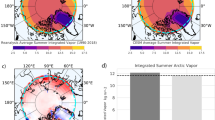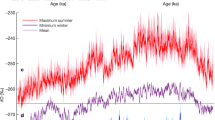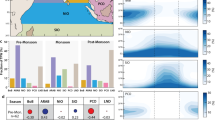Abstract
δ18O in polar precipitation is usually correlated with the condensation temperature1,2. Here, observations of the oxygen isotopic composition of coastal Antarctic precipitation at Syowa Station3,4 during 1974 are re-evaluated, and it is demonstrated that monthly average δ18O is more closely associated with the preceding month's mean temperature than that at the time of sampling. Linear regression indicates that the lag between temperature and isotopic ratio occurs because sea ice extent is a dominant factor for δ18O values in Antarctic precipitation (Fig. 1). The annual growth and decay of Antarctic sea ice parallels the migration of the primary moisture source region which is located in the vicinity of the 0 or 1 °C sea surface isotherm We conclude that the meridional distance from the primary moisture source is the main determinant of δ18O values in coastal Antarctic precipitation.
This is a preview of subscription content, access via your institution
Access options
Subscribe to this journal
Receive 51 print issues and online access
$199.00 per year
only $3.90 per issue
Buy this article
- Purchase on Springer Link
- Instant access to full article PDF
Prices may be subject to local taxes which are calculated during checkout
Similar content being viewed by others
References
Aldaz, L. & Deutsch, S. Earth planet. Sci. Lett. 3, 267–274 (1967).
Picciotto, E., De Maere, X. & Friedman, I. Nature 187, 857–859 (1960).
Kato, K. JARE Data Rep. 36 156–167 (1977).
Kato, K. Nature 272, 46–48 (1978).
Koerner, R. M. J. Glacial. 22, 25–41 (1979).
Dansgaard, W. Tellus 16, 436–468 (1964).
Robin, G. de Q. proc. Canberra Symp. 207–216 (IAHS Publ. No. 131, 1981).
Kato, K. Antarctic Rec. 67, 124–135 (1979).
Zwally, H. J. et al. 4th NASA Weather and Climate Program Science Review (ed. Kreins, E. R.) 335–340 (NASA, Washington DC, 1979).
Cavalieri, D. J. & Parkinson, C. L. Mon. Weath. Rev. 109, 2323–2336 (1981).
Gonfiantini, R., Togliatti, V., Tongiorgi, E., De Breuck, W. & Picciotto, E. J. geophys. Res. 68, 3791–3798 (1963).
Kato, K., Watanabe, O. & Satow, K. Antarctic Rec. 67, 136–151 (1979).
Bromwich, D. H. Antarctic J. U.S. (in the press).
Dansgaard, W., Johnsen, S. J., Clausen, H. B. & Gundestrup, N. Meddr. Grunland 197, 2 (1973).
Maxwell, J. B. Arctic 34, 3, 225–240 (1981).
Friedman, I., Redfield, A. C., Schoen, B. & Harris, J. Rev. Geophys. 2, 177–224 (1964).
Japan Meteorological Agency, Antarctic Met. Data 15, 1–215 (1977).
Fleet Weather Facility, Antarctic Ice Charts 1973–1974 (Suitland, Maryland, 1975).
Streten, N. A. & Pike, D. J. Arch. Met. Geophys. Bioklim. A 29, 279–299 (1980).
Keeley, J. R. & Taylor, J. D. Data Products from First GARP Global Experiment (Marine Environmental Data Service, Ottawa, 1981).
Author information
Authors and Affiliations
Rights and permissions
About this article
Cite this article
Bromwich, D., Weaver, C. Latitudinal displacement from main moisture source controls δ18O of snow in coastal Antarctica. Nature 301, 145–147 (1983). https://doi.org/10.1038/301145a0
Received:
Accepted:
Issue Date:
DOI: https://doi.org/10.1038/301145a0
This article is cited by
-
The role of large-scale drivers in the Amundsen Sea Low variability and associated changes in water isotopes from the Roosevelt Island ice core, Antarctica
Climate Dynamics (2023)
-
The role of Amundsen–Bellingshausen Sea anticyclonic circulation in forcing marine air intrusions into West Antarctica
Climate Dynamics (2018)
-
Seasonal climate information preserved in West Antarctic ice core water isotopes: relationships to temperature, large-scale circulation, and sea ice
Climate Dynamics (2012)
-
Southern hemisphere atmospheric circulation: impacts on Antarctic climate and reconstructions from Antarctic ice core data
Climatic Change (2010)
-
Geochemical characteristics and zones of surface snow on east Antarctic Ice Sheet
Chinese Science Bulletin (2004)
Comments
By submitting a comment you agree to abide by our Terms and Community Guidelines. If you find something abusive or that does not comply with our terms or guidelines please flag it as inappropriate.



